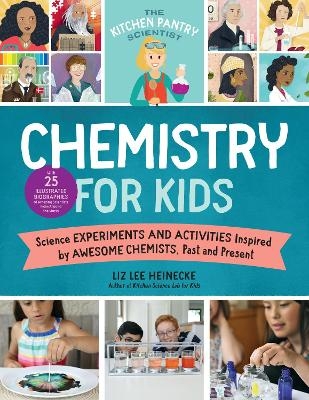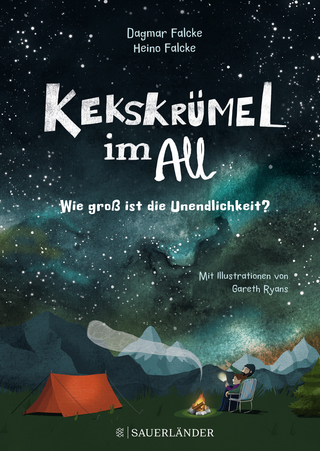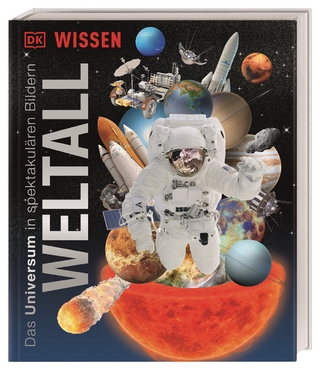
The Kitchen Pantry Scientist Chemistry for Kids
Quarry Books (Verlag)
978-1-63159-830-2 (ISBN)
* 2021 AAAS/Subaru SB&F Prize for Excellence in Science Books in Middle Grade Longlist
* 2021 NSTA-CBC Outstanding Science Trade Book
* 2021 EUREKA! Nonfiction Children’s Honor Book
Aspiring young chemists will discover an amazing group of role models and memorable experiments in Chemistry for Kids, the debut book of The Kitchen Pantry Scientist series.
Replicate a chemical reaction similar to one Marie Curie used to purify radioactive elements. Distill perfume using a method created in ancient Mesopotamia by a woman named Tapputi.
This engaging guide offers a series of snapshots of 25 scientists famous for their work with chemistry, from ancient history through today. Each lab tells the story of a scientist along with some background about the importance of their work, and a description of where it is still being used or reflected in today’s world.
A step-by-step illustrated experiment paired with each story offers kids a hands-on opportunity for exploring concepts the scientists pursued, or are working on today. Experiments range from very simple projects using materials you probably already have on hand, to more complicated ones that may require a few inexpensive items you can purchase online. Just a few of the incredible people and scientific concepts you’ll explore:
Galen (b. 129 AD)
Make soap from soap base, oil, and citrus peels.
Modern application: medical disinfectants
Joseph Priestly (b. 1733)
Carbonate a beverage using CO2 from yeast or baking soda and vinegar mixture.
Modern application: soda fountains
Alessandra Volta (b. 1745)
Make a battery using a series of lemons and use it to light an LED.
Modern application: car battery
Tu Youyou (b. 1930)
Extract compounds from plants.
Modern application: pharmaceuticals and cosmetics
People have been tinkering with chemistry for thousands of years. Whether out of curiosity or by necessity, Homo sapiens have long loved to play with fire: mixing and boiling concoctions to see what interesting, beautiful, and useful amalgamations they could create. Early humans ground pigments to create durable paint for cave walls, and over the next 70 thousand years or so as civilizations took hold around the globe, people learned to make better medicines and discovered how to extract, mix, and smelt metals for cooking vessels, weapons, and jewelry. Early chemists distilled perfume, made soap, and perfected natural inks and dyes.
Modern chemistry was born around 250 years ago, when measurement, mathematics, and the scientific method were officially applied to experimentation. In 1896, after the first draft of the periodic table was published, scientists rushed to fill in the blanks. The elemental discoveries that followed gave scientists the tools to visualize the building blocks of matter for the first time in history, and they proceeded to deconstruct the atom. Since then, discovery has accelerated at an unprecedented rate. At times, modern chemistry and its creations have caused heartbreaking, unthinkable harm, but more often than not, it makes our lives better.
With this fascinating, hands-on exploration of the history of chemistry, inspire the next generation of great scientists.
Dig into even more incredible science history from The Kitchen Pantry Scientist series with: Biology for Kids, Physics for Kids, Math for Kids, and Ecology for Kids.
Liz Lee Heinecke has loved science since she was old enough to inspect her first butterfly. After working in molecular biology research for 10 years and earning her master’s degree, she left the lab to kick off a new chapter in her life as a stay-at-home mom. Soon, she found herself sharing her love of science with her three kids as they grew, chronicling their science adventures on her KitchenPantryScientist website. Her desire to share her enthusiasm for science led to regular television appearances, an opportunity to serve as an Earth Ambassador for NASA, and the creation of an iPhone app. Her goal is to make it simple for parents to do science with kids of all ages, and for kids to experiment safely on their own. Liz graduated from Luther College and received her master’s degree in bacteriology from the University of Wisconsin, Madison. She is the author of Kitchen Science Lab for Kids, Kitchen Science Lab for Kids: Edible Edition, Outdoor Science Lab for Kids, STEAM Lab for Kids, Sheet Pan Science, and Little Learning Labs: Kitchen Science for Kids. Her namesake series, The Kitchen Pantry Scientist, pairs illustrated biographies with engaging hands-on activities inspired by their work. The books in that series include: Chemistry for Kids, Biology for Kids, Physics for Kids, Math for Kids, and Ecology for Kids. Kelly Anne Dalton is a professional artist and illustrator living in the wild mountains of Montana. Working from her charming 1920s studio, Kelly Anne loves creating a wide range of work, from children’s books to decorative greeting cards and gifts. Growing up with a biologist mother, Kelly has had an appreciation for science and nature her entire life, and because of that, she enjoys creating the portraits for the Kitchen Pantry Scientist series. When not drawing, Kelly Anne can be found trail running in the forest, playing with her dogs, and adventuring with her husband.
INTRODUCTION
LAB 1
Tapputi-Belatikallim b. 1200 BCE*
FRAGRANCE DISTILLATION
LAB 2
Galen b. 129 CE*
SOAP
LAB 3
Jabir ibn Hayyan b. 815 CE*
EVAPORATION
LAB 4
Joseph Priestley b. 1733
CARBONATION
LAB 5
Antoine Lavoisier b. 1743
OXIDATION
LAB 6
Alessandro Volta b. 1745
CHEMICAL BATTERIES
LAB 7
William Henry Perkin b. 1838
SYNTHETIC DYES
LAB 8
Dmitri Mendeleev b. 1834
THE PERIODIC TABLE
LAB 9
Svante August Arrhenius b. 1859
TEMPERATURE AND CHEMICAL REACTIONS
LAB 10
Agnes Pockels b. 1862
SURFACE TENSION
LAB 11
Marie Curie b. 1867
ELEMENTAL EXTRACTION
LAB 12
S. P. L. S rensen b. 1868
THE PH SCALE
LAB 13
Mikhail Tsvet b. 1872
CHROMATOGRAPHY
LAB 14
Alice Ball b. 1892
ORGANIC OIL EXTRACTION
LAB 15
Gerty Cori b. 1896
THE CORI CYCLE
LAB 16
Maria Goeppert-Mayer b. 1906
THE NUCLEAR SHELL MODEL
LAB 17
Rachel Carson b. 1907
DISPERSION OF ENVIRONMENTAL CONTAMINANTS
LAB 18
Anna Jane Harrison b. 1912
ORGANIC COMPOUNDS AND ULTRAVIOLET LIGHT
LAB 19
Rosalind Franklin b. 1920
DNA STRUCTURE
LAB 20
Edith Flanigen b. 1929
MOLECULAR SIEVES
LAB 21
Tu Youyou b. 1930
MEDICINAL PLANT COMPOUNDS
LAB 22
Ada Yonath b. 1939
RIBOSOME STRUCTURE
LAB 23
Margaret Cairns Etter b. 1943
CRYSTALLOGRAPHY
LAB 24
Linda Buck b. 1947
OLFACTORY CHEMISTRY
LAB 25
Raychelle Burks b. 1975
COLORMETRIC SENSORS
GLOSSARY
RESOURCES AND REFERENCES
THE PERIODIC TABLE
ACKNOWLEDGMENTS
ABOUT THE AUTHOR
ABOUT THE PHOTOGRAPHER
ABOUT THE ILLUSTRATOR
INDEX
| Erscheinungsdatum | 07.05.2020 |
|---|---|
| Reihe/Serie | The Kitchen Pantry Scientist |
| Illustrationen | Kelly Anne Dalton |
| Zusatzinfo | color photos |
| Sprache | englisch |
| Maße | 216 x 279 mm |
| Themenwelt | Kinder- / Jugendbuch ► Sachbücher ► Naturwissenschaft / Technik |
| Schulbuch / Wörterbuch | |
| ISBN-10 | 1-63159-830-9 / 1631598309 |
| ISBN-13 | 978-1-63159-830-2 / 9781631598302 |
| Zustand | Neuware |
| Informationen gemäß Produktsicherheitsverordnung (GPSR) | |
| Haben Sie eine Frage zum Produkt? |
aus dem Bereich


